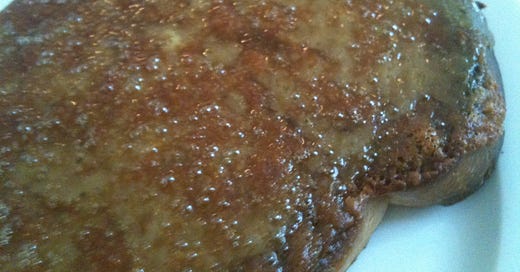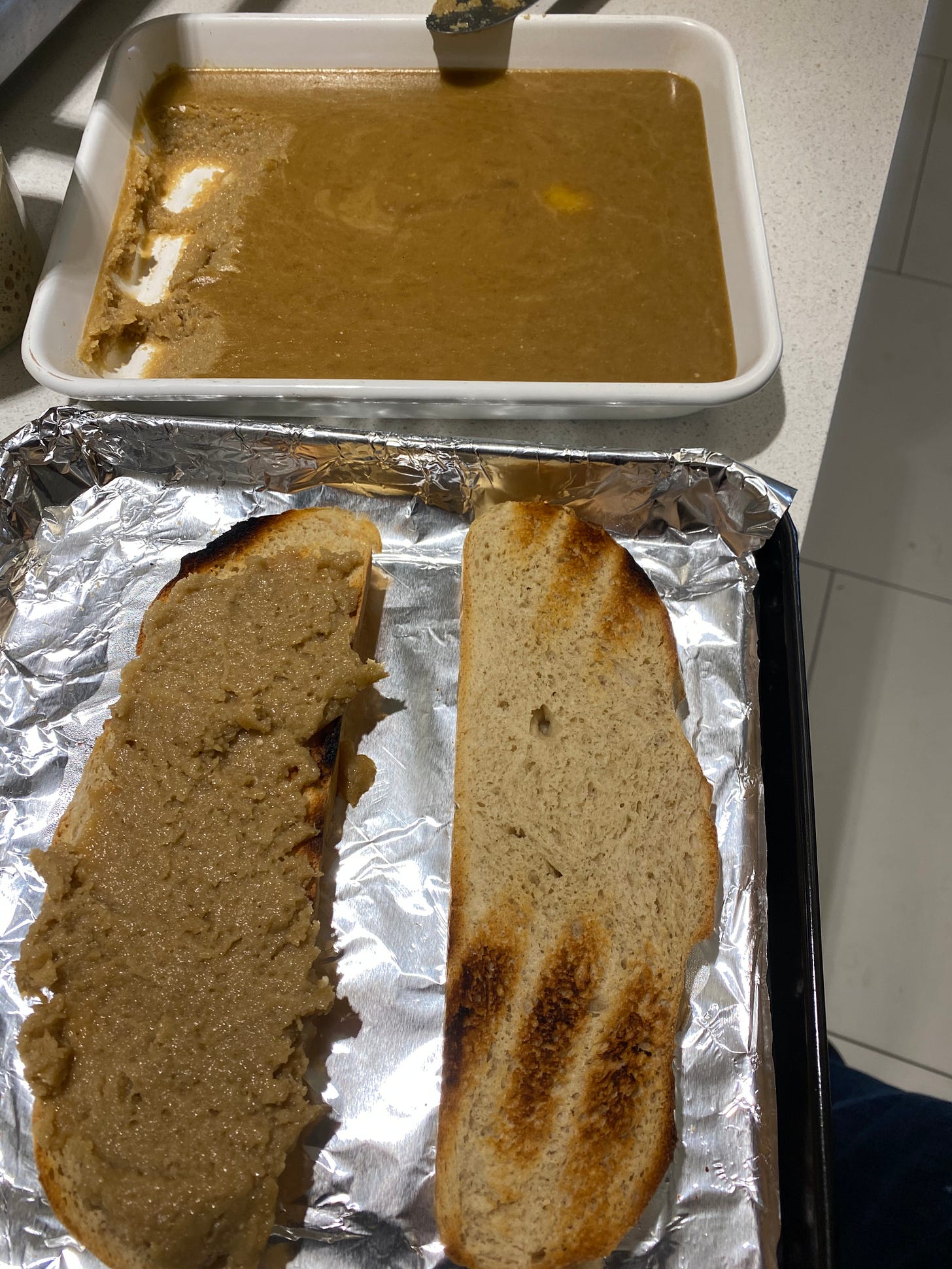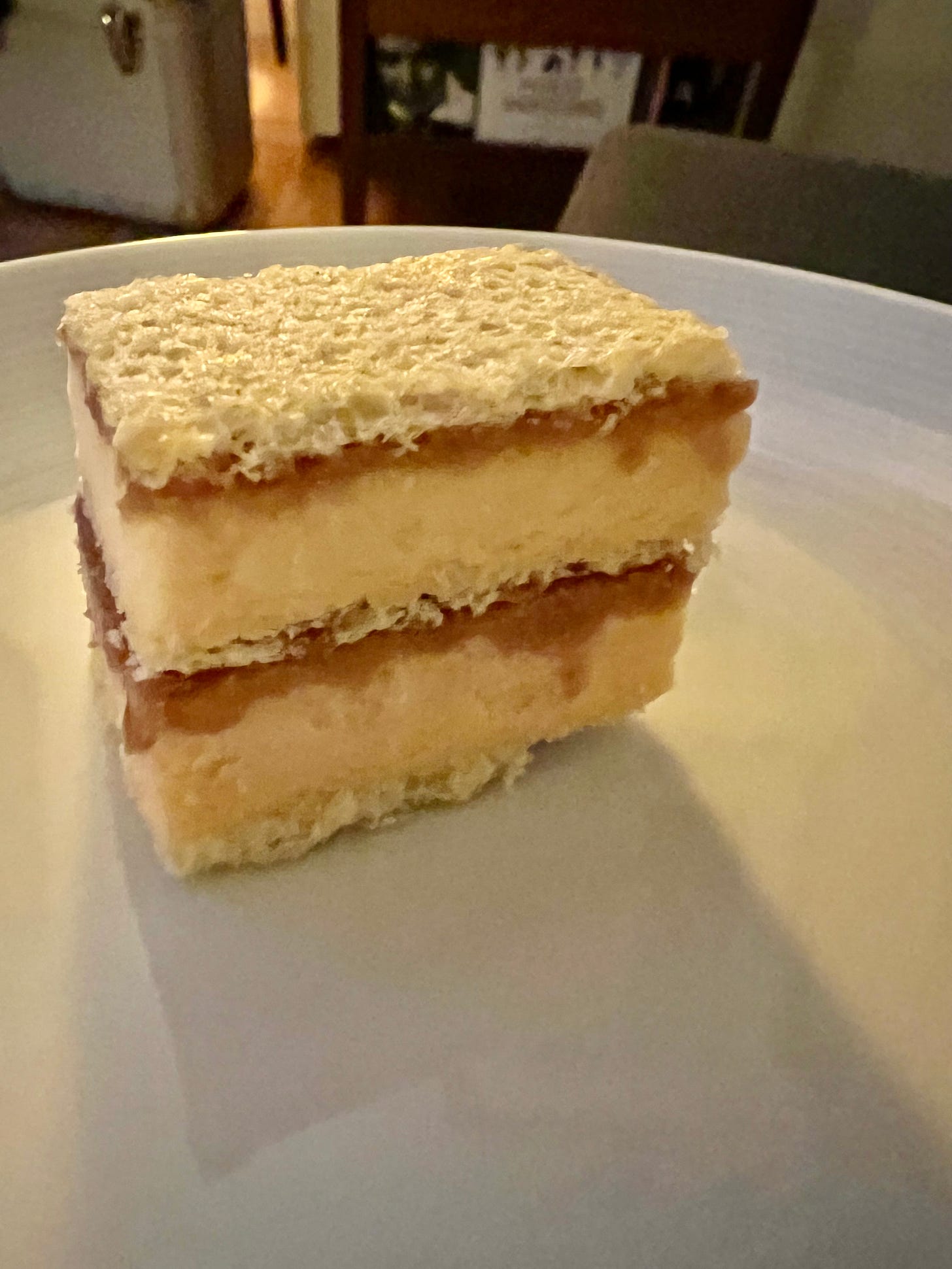Issue #55: Rare Bits of London
A Favorite Eatery, The World's Best Cheese Toast: Welsh Rarebit, Happy, Messy Endings
Hi, all. I’m in London for a gathering of a Chef’s Manifesto Action Hub, the local node of a global network of chefs working to support the UN’s Sustainable Development Goal #2, that is, the goal to achieve zero hunger and sustainable agriculture by 2030 (see UNSDG2). We are laying the groundwork for a campaign to double bean consumption globally because of the personal and planetary health benefits of growing and consuming legumes and pulses. (Look for bean recipes in future newsletters!)
I used to come to London once or twice a year for various meetings and other projects. Sometime before the pandemic, though, my travel patterns changed. Back then I had a loose handle on what was happening on the London restaurant scene, but now my knowledge is way out of date.
When I was looking into what restaurants I might want to try on this trip, I was overwhelmed by the options. I asked for recommendations from local friends and scanned lists of best, new, and essential London restaurants. There were too many options. I really couldn’t decide.
Luckily, on the evening of my arrival, I was meeting a new colleague face-to-face for the first time for dinner and he took it upon himself to make us a reservation. Given that something we have in common is our doctoral research about restaurant reviewing. I trusted him to make a good choice. To my delight, he picked St. John, a place he had wanted to try since moving to London six months prior. St. John is a restaurant I love.
I have been to St. John almost as many times as I’ve been to London, a dozen or so. It is the opposite of new and trendy; it is iconic. (Twenty minutes into our meal a family of six who had been on my arrival flight earlier that day walked in for dinner. The place is known.) Fergus Henderson was one of the modern pioneers of new British cookery and his casual, comfortable, friendly, and still very reasonably priced restaurant defined an era. The aesthetic is minimalist utilitarian, the food simple and soulful. Though meat-centric by design, with a focus on offal to boot, the vegetables and baked goods have always also been outstanding.
Our meal Saturday was great, again, showcasing ingredients more than the creativity of the kitchen. We enjoyed roasted bone marrow with parsley salad on toast and kohlrabi salad with capers to start. Then grilled ox tongue and roasted Middle White pork. On the side, fine potatoes, more greens, and one my favorite things, Welsh Rarebit.
What’s Welsh rarebit, you might ask? as did my dining companion Saturday. You could call it a pretentious name for cheese toast. In fact, it’s more like cheese fondu on toast, made with roux, beer, and fine cheddar, Worcestershire sauce is key. In trying to find something about its history and the origin of that name, legend and lore collide into a mess. (More on mess later.)
What seems verifiable is that something similar to Welsh Rarebit has been eaten by the Welsh, apparently known cheese lovers, for several hundred years. It was originally called caws pobi, Welsh for “toasted cheese.” By the 18th century it appeared in print as Welsh Rabbit, but likely to avoid misleading folks that it contained any bunny, the name morphed into Rarebit, a made-up word that is used nowhere else in the Welsh kitchen or elsewhere.
If my family’s food history is any indication, Welsh Rarebit must have been a trend in America around the 1960s because the name and the dish made rare appearances in our house. It was the era of Worcestershire Sauce, after all. I will bet money that Graham Kerr, aka The Galloping Gourmet, devoted an episode to it. My mother still called it Welsh Rabbit.
Unassuming and almost drab to look at, the Welsh Rarebit at St. John is about as perfect as one imagine’s Welsh Rarebit can be. When I look through my photo library on my phone, I see many pictures of this rarebit, a few of which I’m sharing with you (even though their quality is poor).
In the winter of 2021, still in the early throws of the pandemic, I had some good English cheddar and some freshly baked sourdough bread and I had the idea to recreate St. John’s Welsh Rarebit. I found online what was said to be the definitive recipe reprinted from their cookbook by Food & Wine magazine, which I adapted for an American kitchen.
Having just enjoyed the Rarebit again at St. John, I couldn’t help but want to share the recipe. It’s simple and delicious, and you should try it a couple of times between now and September 3, which t is National Welsh Rarebit Day, a holiday worth celebrating.

RECIPE: St. John’s Welsh Rarebit
Serves at least 4, depending on the dimensions of your toast
1 ½ tablespoons butter
1 ½ tablespoons flour
1 teaspoon English mustard powder, such as Coleman’s
1/2 teaspoon cayenne pepper
1 tablespoon Worcestershire sauce
1 cup Guinness stout
1 pound very sharp Cheddar cheese, grated
4 large, thick slices homemade or bakery white bread
In a small saucepan, melt the butter over medium heat. With a wooden spoon or rubber spatula, stir in the flour, and let cook for 3 or 4 minutes until you can perceived the cooked flour smell of pancakes. Don’t let it brown. Add the mustard powder and cayenne pepper. Switch to a whisk and stir in the Worcestershire sauce and the Guinness to make a sauce. Stir in the cheese in small handfuls to melt into a smooth paste. When the dish comes together into a coherent mass, remove from the heat. Pour into a shallow container to cool and set.
Meanwhile, line a sheet pan with aluminum foil. Preheat a broiler. Toast the slices of bread on both sides. Allow the toast to cool for a minute or two, then spread one side thickly with the rarebit mixture to the edge of the toast, about 1/3 inch thick. If it doesn’t spread easily, press it on with your fingers. Put the prepared toasts on the prepared baking sheet and place under the preheated broiler until golden and bubbling. Watch closely. Move the pan around, if necessary, so the cheese browns darkly and evenly. Serve while warm.
Happy Endings
A perfect finish to our near perfect meal was strawberry Eton mess. Like vitello tonnato, Eton mess is a dish I have to order when I see it on the menu. How lucky it is strawberry season. Eton mess has been a traditional dessert at the tony private school since the 1930s, when its base was cream or ice cream served with fruit. Strawberries are traditional. Meringue was apparently added later. As I dipped my spoon into the bowl, I spotted a server carrying a beautiful thing, what I would call a ginormous strawberry Pavlova about to meet its future as a mess.
Further on the subject of happy endings, my friend Johnny pointed out these impressive little ice-cream sandwiches called Happy Endings, made locally in London and on offer at gourmet shops around town. They pack an impressive amount of flavor into a cute little package. Here is half of a très leches parfait with salted dulce de leche sandwiched between layers of sponge cake. Seek them out.
On the related subject of “happy dénouements,” I’ll also note that if you are heading to London and you can’t get a reservation at St. John, you might be able to more easily pop into St. John Bread and Wine, Henderson’s other, somewhat more casual restaurant in Spitalfields, where many of the same items are on the menu. Hungry for more, I confess, I went there the next day for lunch. It didn’t disappoint.













Good to know! Thanks.
"Tea & Sympathy" in the Village has a delicious Welsh Rarebit. And don't miss their Treakle Pudding with warm custard!